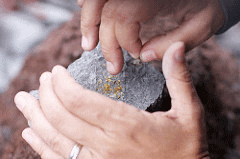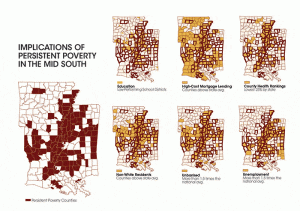
Photo by Kanu Hawaii, via flickr, CC BY 2.0
One of America’s best writers, William Faulkner, in explaining why he always set his fiction in the South, said: “I discovered that my own little postage stamp of native soil was worth writing about, and that I would never live long enough to exhaust it.”
Though I do very different work from Faulkner, I share his belief that place, whether thought of as a “little postage stamp of native soil,” or in the parlance of modern data analyst as a “ZIP code,” matters.
When we set out to create equal opportunity for people who live in communities plagued by entrenched poverty, we must work in a comprehensive, sustained, and indeed, exhaustive way.
This truth is vividly driven home by a series of maps of the Mid South region developed by HOPE’s data analysts. The central map shows that in Arkansas, Mississippi, and Louisiana, 97 of the 221 counties and parishes, a full 44 percent, meet the federal government’s definition of persistent poverty. This label defines counties and parishes where at least 20 percent of the population has lived below the federal poverty level for more than three decades.

Overwhelmingly, the same counties and parishes characterized by persistent poverty are the same counties and parishes with the highest unemployment rates, the lowest performing schools, the worst health outcomes, the most predatory lending, and fewest options for banking services.
As the evidence mounts showing that a person’s prospects for economic success are determined not only by individual circumstances, but by the circumstances of his or her surrounding community, the urgency grows to transform these places.
These maps show us that well-meaning, but scattergun initiatives like making transfer payments to individuals, creating a world-class middle school, or building a state-of-the-art community health center alone is not going to work. We cannot afford to tackle the one problem that fits within our box and cross our fingers in the hope that someone else will tackle the other problems. Persistent poverty communities require comprehensive, coordinated solutions to address the range of challenges that confront their residents.
Nor can we afford to be picky about where the resources come from. State and federal government, foundations, banks, private employers, and every individual share a vested interest in stable neighborhoods, economic prosperity and the common good.
Wherever there are solutions and resources, we must bundle them together to change these maps and transform the ZIP codes in persistently poor places, knowing that every little postage stamp of native soil is worth saving, and that we can never live long enough to exhaust their potential.





Comments